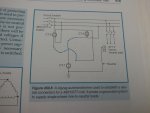smitty1701
Member
- Location
- boston, ma
Hello,
I have a question about properly connecting a Zig Zag transformer for line to neutral loads. I want to use a zig zag to derive a neutral line so that my system can be used with a 3-Phase Delta transformer, currently only supports Wye with a neutral. When i look in the NEC, specifically 450.7, it shows the neutral being taken from one of the legs of the zig zag. However when you look at 450.8 the neutral connection is where all the winding's of the zig zag meet. Do you really wire the zig zag differently if you want to use it for deriving a ground or use it for line to neutral loads? Thanks for any help
I have a question about properly connecting a Zig Zag transformer for line to neutral loads. I want to use a zig zag to derive a neutral line so that my system can be used with a 3-Phase Delta transformer, currently only supports Wye with a neutral. When i look in the NEC, specifically 450.7, it shows the neutral being taken from one of the legs of the zig zag. However when you look at 450.8 the neutral connection is where all the winding's of the zig zag meet. Do you really wire the zig zag differently if you want to use it for deriving a ground or use it for line to neutral loads? Thanks for any help




